
We’ve all suffered through bad speeches and disappointing conventions.
Dull keynotes, irrelevant presentations, overly simplistic seminars, and lengthy virtual events that drain our energy and make multitasking irresistible.
No one wants to be the event planner who’s responsible for a speaker lineup like that.
After all, your reputation is on the line with each event – and you want audiences to leave feeling energized, inspired, and eager to apply what they’ve learned.
If, instead, your audience is unengaged, low-energy, and unimpressed with the presentations…
…if they don’t feel like attending was worth their time or money…
…and if their thoughts and behaviors aren’t positively impacted by what they’ve experienced…
…well, the event hasn’t succeeded. And the audience will be less likely to return next year.
Hiring the right speakers – and putting them in the right places in your program – is key to creating a valuable event experience for your audience.
 Selecting the right speaker requires knowing what you want, being clear on how you want your audience to respond, and understanding what kinds of speakers can produce this result for you.
Selecting the right speaker requires knowing what you want, being clear on how you want your audience to respond, and understanding what kinds of speakers can produce this result for you.
Customer service speakers might wow a breakout audience with their expertise and practical advice – but they may not be capable of producing the energy and motivation required of an opening keynote address. Likewise, a stellar keynote speaker may not translate well to a virtual venue, where keeping an audience glued to their screens requires a very different skill set than does a physical stage.
The right presentation, delivered at the right point in the program, can set the mood for what comes next. For example:
- A great opening keynote can generate excitement about the coming program and encourage more active attendance.
- A mid-morning workshop can provide attendees with insights and ideas that they’ll carry into the next session.
- A post-lunch presentation can reinvigorate the room and prime the audience for an afternoon of focused participation in breakouts and workshops.
- A closing address can bring together multiple threads and insights, summarize the big takeaways, and tie a bow on the entire experience – so attendees return home feeling invigorated.
Conversely, using the wrong speaker at the wrong points in the event can drain the energy from the room, create a mood that’s counterproductive to the goals of the event, and make the audience wish they’d stayed home.
So how to avoid this?
That’s what we’ll cover in this article. I’ll share:
- The difference between the various types of speakers -- content expert versus keynote speaker versus virtual keynote presenter
- What each of them can do for your event
- And how you can use their skills creatively to design a more compelling program for your attendees
Let’s get to it!

The Customer Service Speaker: Providing Expert Presentations to Educate Your Audience.
The majority of customer service speakers are industry experts who possess deep knowledge of some aspect of customer service. They might be specialists in a particular industry, vertical, or service channel. Or they might be experts in digital customer service, user experience, analytics, or – like me – building service cultures.
No matter their expertise, a customer service speaker’s primary value to your event is educational. When their content is relevant and compelling to your audience, customer service speakers can be a tremendous asset to breakout sessions, panel discussions, and workshops.
Of course, customer service speakers should be competent presenters – but they don’t have to be standout performers. If their material is good, your audience will appreciate and benefit from what they’ve learned.
Play to the Strengths of Your Customer Service Speakers.
If education and training are important event goals, then expert speakers can deliver. Their presentations are likely to be filled with actionable ideas and advice that can make a real difference in your organization.
A strong speaker addressing a relevant topic will leave the audience feeling inspired and motivated to implement. And, because the speaker’s approach is often more practical than inspirational, the audience will leave in possession of the tools and knowledge that they’ll need to take next steps.
Of course, you will need to ensure that the speaker is:
- Truly expert
- Speaking on a topic that’s relevant and interesting to the audience
- Able to clearly articulate the benefits of their approach and earn the audience’s attention
- Presenting on a topic that’s well-aligned to the audience’s needs and your overall event goals
- Willing and able to customize their examples and takeaways for the audience and industry
Expert customer service speakers can deliver incredibly powerful presentations – provided they’re addressing the right audiences at the right times.
Customer Service Speakers ≠ Keynote Speakers.
But from some of your speakers, you’ll need more.
An event stuffed with expert speakers risks draining energy from the audience and overwhelming them with detail. Your event will also need speakers who can manage the energy, set the mood, and guide the audience through the event experience.
These are the roles played by your keynote speakers — and you shouldn’t assume that a customer service expert will be up to that task.
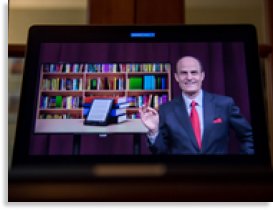 That’s because keynote presentations have radically different requirements than smaller educational sessions.
That’s because keynote presentations have radically different requirements than smaller educational sessions.
Some of these differences are logistical: Keynotes generally address much larger crowds in front of blinding lights. Their presentations are much more finely choreographed and come with related requirements around lighting, sound, audio-visual effects, and stage technology.
But some of those differences have to do with the flow of the event. Keynote speakers will understand their place in the program, create the requisite mood and energy, and help the audience assimilate ideas and learnings from other presentations. In contrast, customer service speakers may not attend any sessions beyond their own, and they’re unlikely to be in a position to do any of the summary, consolidation, and wrap-up that a keynote speaker might.
And successful keynote addresses require very different skills from the speaker. The presenter needs to be able to work the room, control the mood and energy, and prime the audience for the rest of the experience. Doing so effectively requires a great deal of talent and preparation.
You certainly may find customer service speakers with the chops to deliver an outstanding keynote address. I often serve as both expert presenter and keynote speaker at conferences, and I know others who do as well. But you can’t assume that this will be the case.
Instead, you’ll need to be clear on what you need – and very careful about how you prepare your speakers.
How to Help Expert Customer Service Speakers Give Stellar Presentations.
Expert speakers bring lots of knowledge and experience to the table. But they won’t know how to make their expertise applicable to your audience – unless someone tells them.
Whether it’s the meeting planner or a member of the senior leadership team, someone in your organization should prepare a thorough brief for your speakers.
Your customer service speakers should understand:
- What service issues the company is working on
- What the company launching, improving, or changing in order to provide better service
- The nuances of your industry
For example, say your organization in the middle of a merger. The expert speaker should be briefed on how the merger is going, what service issues have arisen, how the organization is trying to address them, and what challenges or roadblocks they’ve run into.
 With this kind of granular detail, your expert speakers will be in a position to customize their presentation for maximum impact and relevance to your audience.
With this kind of granular detail, your expert speakers will be in a position to customize their presentation for maximum impact and relevance to your audience.
Similarly, your speakers will need a solid understanding of the industry and space your organization operates in, so they can seek out the most relevant examples and case studies for your audience.
For instance, imagine that you bring in a guest expert on e-commerce customer service – but your audience is working in the medical space. Someone will need to brief the expert on the different roles and service opportunities in the industry, explain how e-commerce technology is currently in use, and indicate what kinds of examples might be most useful for the audience. Or, if your guest is already expert in the medical space, you might prompt him or her to incorporate ideas from other industries that might be relevant and insightful for your audience.
A good customer service speaker will be eager to learn more about your industry, your goals, and your organizational context, and they’ll weave that knowledge throughout their presentation.
But they will absolutely need your help to understand where the opportunities are and what will be of most use to your audience.
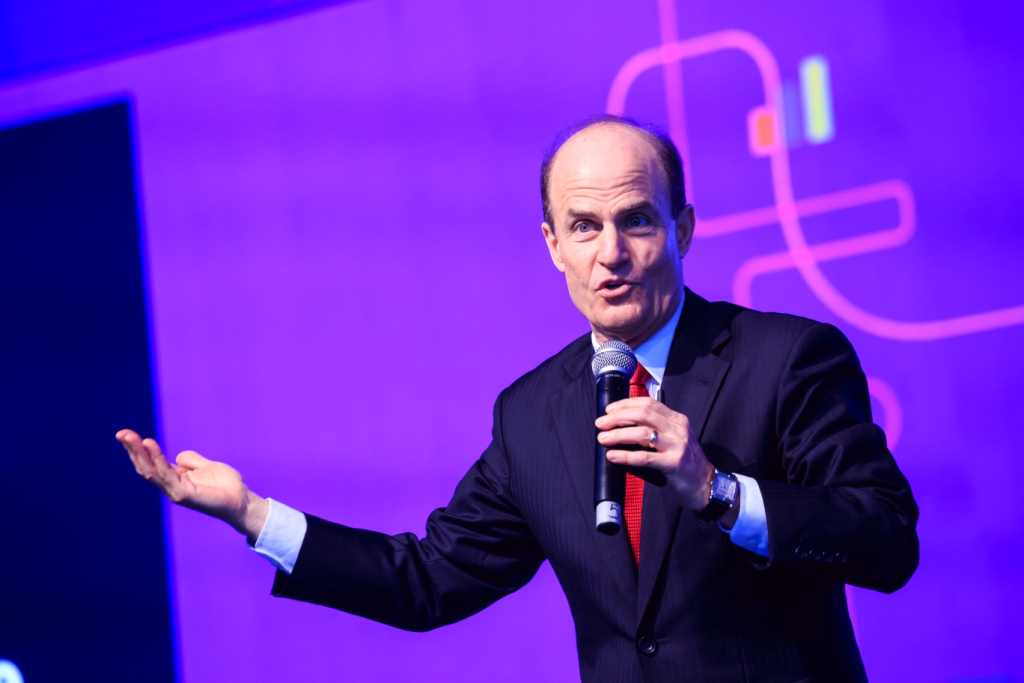
Energize Your Audience with an Inspirational Customer Service Keynote Speaker.
Keynote speeches function almost like touchpoints at different stages of the event. The keynote address creates an opportunity to bring everyone together, highlight the big takeaways, and set the stage for what comes next.
As a result, keynote speakers have a responsibility to the overall flow of the convention – and they must be up to that task.
They set the tone, manage the mood, maintain energy in the room, and help focus the audience’s attention and motivation. Plus, they set up and highlight the most important themes of the event, and they’ll prime the audience to leave feeling ready and motivated to implement what they’ve learned.
A keynote speaker who isn’t actively engaged with that process is unlikely to deliver the experience you’re hoping for…
…but one who partners with you to understand your goals and your audience’s context can create a transformative, impactful experience for your attendees.
Get More Value From Your Customer Service Keynote Speakers.
Because they’re so keyed into the goals, context, energy, and mood of the event and its audience, keynote speakers play a powerful role in its overall success.
And because they bring a flexible set of skills to the table, you may find other ways to make the most of your keynote speakers’ participation.
For example, one of your keynote speakers can serve as an event emcee. A skilled emcee generates excitement, enables smooth transitions, and helps the audience understand individual sessions in the context of the full event – a skill set that aligns perfectly with that of a keynote speaker!

You may also recruit your keynote speaker to provide some kind of supplementary or other experience, either before or after the event. Supplementary sessions provide the opportunity to extend and deepen what attendees learn during the convention – or they can provide more specific training to a particular group of attendees.
Supplementary sessions can be particularly effective when you’re working with a customer service keynote speaker who is also a domain expert. During the main event, the speaker can focus on the big picture, while using supplementary sessions to help attendees deepen their understanding and implement what they’ve learned.
How to Prepare Your Speaker for a Sizzling, High-Impact Keynote Address.
Keynote speakers are (or should be) a versatile bunch.
They can calibrate their performances to be energizing, inspirational, motivational, challenging, or educational – or they can settle the room and prepare attendees for hard work ahead.
But to do any of that, they need to know what reaction you want from the audience – and what kinds of examples and case studies will be most relevant to them.
Good keynote speakers will work with the event planner or senior leadership to understand the organization’s goals, challenges, service culture, and service initiatives. They’ll develop a keen understanding of the event’s objectives, and they’ll tailor their content, presentation, and even humor accordingly.
 When I give keynotes, I like to see the presentation notes, slides, and discussion points for the sessions on either side of mine, so that I can customize my keynote speech and locate it in the full event program. At in-person events, I watch other presentations from the back of the room, chat with attendees during the breaks, and share meals with the people I meet. That way, by the time I give my talk, I have my finger on the pulse of the convention, and I can tailor my address to reflect what the audience has already experienced – and what they’ll experience next.
When I give keynotes, I like to see the presentation notes, slides, and discussion points for the sessions on either side of mine, so that I can customize my keynote speech and locate it in the full event program. At in-person events, I watch other presentations from the back of the room, chat with attendees during the breaks, and share meals with the people I meet. That way, by the time I give my talk, I have my finger on the pulse of the convention, and I can tailor my address to reflect what the audience has already experienced – and what they’ll experience next.
Your keynote speaker will have their own methods for preparing their talk – but you’ll need to do your part to be sure they fully understand the context and goals of your event.
As you prepare them for the convention, be sure to address the following:
- Goals and Outcomes
What are your primary objectives for this event? What do you want this particular session to accomplish? - Audience
Who will be in the audience? What are their most pressing concerns? What should be their main takeaways from the convention? - Organization/Industry Context
What’s going on in your organization or industry right now? What are your biggest challenges? What should the speaker understand about your industry, your company, and your competition. - Service Goals and Methods
What are your organization’s goals and objectives around customer service? What are you doing now to deliver, monitor, and improve service in your company? - Agenda
What is the meeting agenda, and where does the speaker’s presentation fit in? Who else is presenting, and what are the goals of each session? If it’s a multiday event, what’s happening on each day? - Promotion
What kind of pre-event promotional opportunities are there? How might you tease content for the audience? When and where will you use teaser videos, social media posts, or other content provided by the speaker? - Call to Action
What action do you desire from the attendees after the convention is over? (For example, you may want people to register for an upcoming event, participate in a contest, or sign up for a special offer.) What offers might the speaker make that could benefit your audience? - Slides and Recordings
Will you make slides or recordings of the presentation available to attendees (or others) at a later date? If so, that should be part of your contract negotiations. - Technology
What technology will be used and what are the constraints associated with that? Can the speaker use slides? A green screen? Will there be professional producers involved?
An experienced keynote speaker will ask for much of this – but the more you can provide up front, the better prepared your speaker will be.
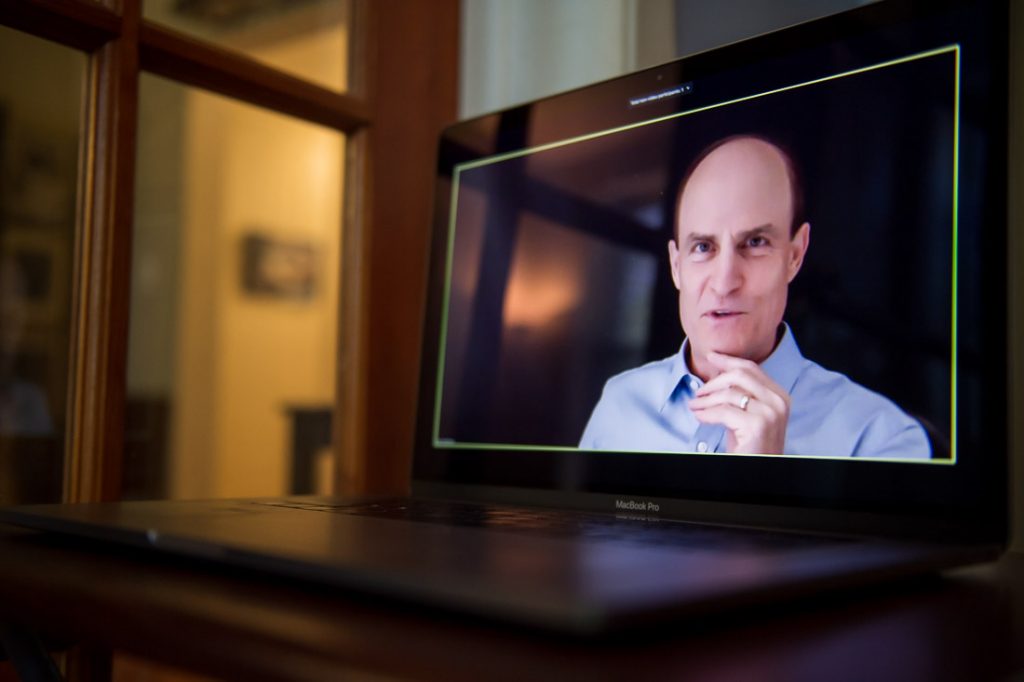
Host Outstanding Online Events with a Skilled Customer Service Virtual Keynote Speaker.
What happens, though, if your convention is taking place online, as so many are nowadays?
As more and more events go online, audiences have leveled up their expectations for what a virtual keynote speaker can do.
But the skills needed to deliver a riveting online performance can be very different than those needed for an in-person event.
1. Because the entire event happens on-screen, a virtual keynote speaker must be able to interact with the camera and connect with the audience in a very different way.
For many speakers, this is the most challenging part of translating an in-person keynote to a virtual space. In person, it’s easy to take the temperature of the room, adjust to audience reactions on the fly, and incorporate audience interaction into the presentation itself. Plus, speakers can learn a lot about the audience just by being in the room during other presentations, taking to attendees, and paying attention to what people are talking about.
All those ways of connecting with and responding to the audience are gone – or radically reduced – in a virtual presentation. To replace those in-person cues, virtual keynote presenters must prepare for other forms of audience interaction.
Skilled virtual speakers will be able to ask for participation or pull from the chat in the moment, and then weave the results into their presentation. They might communicate with audience members in advance and then bring those folks on for certain portions of the presentation. Or they might solicit audience participation on the fly and respond in the moment.
2. Virtual keynote speakers must be able to work effectively in an asynchronous environment.
These audience-interaction challenges are exacerbated by the use of pre-recorded presentations during online events.
Asking a speaker to record a presentation for later use allows for more flexibility in the event structure and — depending on your agreement with the presenter — you may be able to use that recording in multiple ways. (One particularly effective use is to commission a series of 3-5 post-convention videos for use in retreats and training sessions in the weeks after the event. )
But recording an hour-long video that can capture and maintain the audience’s undivided attention is no mean feat – and many keynote speakers will not be up to the task.
3. Virtual keynote speakers must design presentations that hold the audience’s attention in an online environment.
In-person keynotes rely on stagecraft and the speaker’s stage presence to keep the audience focused and engaged.
But in an online environment, you don’t have either.
That’s why a virtual keynote speaker needs to design a presentation that keeps all eyes glued to the screen. Strategic use of slides, video, a whiteboard, or a flip chart – coupled with the ability to change camera angles and zooming – can highlight key ideas and draw the audience’s attention to particular components of the presentation.
Doing this effectively requires video and design skills, a versatile tech set-up, and a high level of proficiency working in the interactive digital environment.
4. Virtual speakers need robust, flexible technology that won’t break or slow down at key moments.
We’re long past the days when a pair of headphones and a Powerpoint deck would serve to deliver a virtual keynote presentation.
Today’s customer service virtual keynote speakers have (or should have) professional-quality sound and video with plenty of backup. (At the very least, there should be a backup internet connection and a backup computer with the presentation cued up and ready to go.)
My own set-up is designed to give me maximum flexibility without compromising reliability. I have a specially designed, sound-proofed, in-home video studio, with professional lighting, cameras, and sound equipment, which allows me to create dynamic virtual experiences.


At any moment in the presentation, I might address the audience from my “stage”…
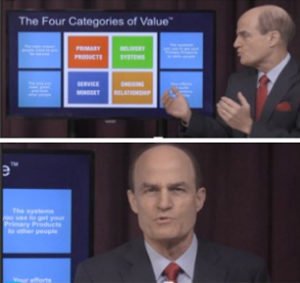 …use visual aids to clearly narrate important ideas…
…use visual aids to clearly narrate important ideas…
…lean in to bring focus to key messages…
…show images from a traditional slide deck…
…or teach from an old-fashioned flip chart.
With the click of a button, I can shift between any of these angles, so the audience remains focused on the presentation and the impact of the message is never lost.
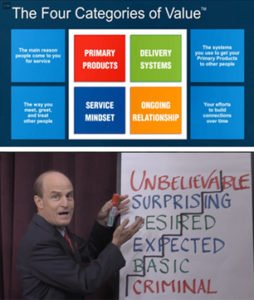 But all that flexibility would be useless in the case of an internet or power outage – which is why I have lots of redundancy built into the system.
But all that flexibility would be useless in the case of an internet or power outage – which is why I have lots of redundancy built into the system.
For starters, I have hard-wired and wireless internet connections delivered through two different providers – so there’s reliable backup in case of a provider outage.
Next, I’ve got two computers running the presentation at all times. Should there be any issue with one system, I can seamlessly switch to the other.
Finally, I set up a laptop linked to a mobile hotspot, so, in case of a power failure, my presentation and my internet connection are safe and sound, running on batteries.
Regardless of their precise set-up, your virtual keynote presenter should have a similar system in place for reliably delivering engaging presentations – even if something goes wrong.
Be sure to ask them:
- Where they’ll present from and what kind of equipment they use
- How they use their tech set up to generate more visual interest and capture the audience’s attention
- How they’ll guarantee that their space remains free of interruptions, loud noises, and other interference
- Whether their internet connection is wired or wireless
- Their contingency plans in case of internet disruption or electrical failure
Add More Value To Your Convention Program.
Despite its challenges, the virtual convention format provides several opportunities to extend the role of the keynote, to provide more energy and cohesion for your event. Your speaker may be able to:
- Act as an emcee. Just as with a live event, recruiting a keynote speaker to act as the convention emcee can help you create and maintain a mood of excitement and anticipation throughout the event, while bringing together some of key takeaways and insights.
- Add more value to the program. Your virtual keynote speaker can design various components for you to play at various points during the convention – perhaps SOMETHING to be played after lunch or SOMETHING ELSE as part of the kickoff event.
- Extend the training experience. Your keynote speaker should get to know your organization, your people, your goals, your industry and your desired outcomes. Take advantage of their prep work, and build out extended training experiences for some or all event attendees. You might ask your speaker to:
- Deliver a bonus post-event training
- Lead a workshop or Q&A session
- Participate in a panel or round-table discussion
- Deliver a pre-event presentation in order to prime attendee for the convention experience
- Design an entire educational program. This is far and above the role most keynote speakers would play, but a keynoter who with domain expertise and good teaching skills can create an entire educational experience built around the event.
For example, your speaker could tape a series of trainings around creating a customer-obsessed service culture, to be delivered to senior leadership over the four months following the event.
Or you might conduct an intensive training in the week leading up to the event, with morning training sessions and homework assignments that prepare the group to get more from the convention itself.
Regardless of whether you decide to engage a keynote speaker for a single presentation or for additional components of the program, you’ll want to be sure they’re well prepared to deliver the best experience possible to your audience.
Your virtual speaker will need all the same context and insight you would provide to an in-person speaker. But because they aren’t in the room with the audience, they’ll need more help and support from you in understanding the audience’s needs, concerns, and desires.
And, of course, in a virtual environment, the technological considerations are also vital. Be sure that your speaker is comfortable with the technology platforms in use, can design and produce engaging virtual presentations, and possesses a rock-solid set of backup systems and procedures.
How to Create a Convention Program That Delivers.
Whether you’re flying a speaker to an in-person event…
…or hiring them to deliver a virtual keynote…
…you can make the most of their participation (and your budget) by recruiting them to engage in more deeply with the event, the audience, and the program.
Ideally, you’d work with a speaker like me, who has subject matter expertise, a great stage presence, AND the chops to inspire and engage your audience virtually. Speakers this versatile can be hard to find – but when you land them, you have the chance to use their skills in multiple ways in your program.
In fact, for both in-person and virtual events, it’s worth considering how you can make the most of today’s technology to deliver more value to your participants.
Personally, I love giving keynotes – but even more than that, I enjoy getting to know and contribute to an organization. As a keynote speaker, I consider myself a partner in the success of the event – and I’m eager to help organizers in any way I can.
I often work with event planners and leaders not only to deliver a fantastic keynote address, but to design more engaging programs, set the tone and maintain audience energy; and supplement keynote address with additional breakouts, pre- and post-event follow-ups, and even extended training sessions that help executives implement what they learn at the event.
With the right speaker as your partner, the possibilities for creating a more impactful event are endless.
As you’re vetting speakers, pay close attention to the particular skill set that each brings to the table – and look for ways to maximize the value they can provide for you.
If you’d like to discuss how I might contribute to an upcoming event, send me a message here.
Energize and Inspire Any Team or Audience
Align your leadership team around a common service vision.
Motivate your staff to deliver on-the-spot service daily.



